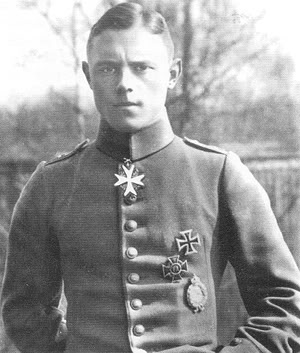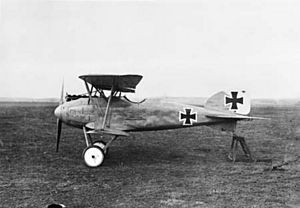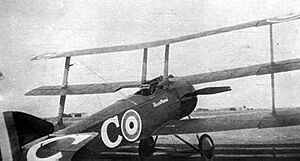Karl Allmenröder facts for kids
Quick facts for kids
Karl Allmenröder
|
|
|---|---|
 |
|
| Nickname(s) | Karlchen |
| Born | 3 May 1896 Wald, Rhine Province, German Empire |
| Died | 27 June 1917 (aged 21) Zillebeke, Belgium |
| Buried |
Evangelical Cemetery, Wald, Germany
|
| Allegiance | |
| Service/ |
Artillery, Air Service |
| Years of service | 1914–17 |
| Rank | Leutnant |
| Unit | Field Artillery Regiments 62 & 20; Flieger-Abteilung (Artillerie) [Flier Detachment (Artillery)] 227; Jagdstaffel 11 |
| Commands held | Jagdstaffel 11 |
| Awards | Kingdom of Prussia: Pour le Merite; Royal House Order of Hohenzollern; Iron Cross First Class; Grand Duchy of Oldenburg: Friedrich-August Cross; Kingdom of Bavaria: Militar Kronen Orden (posthumous) |
| Relations | Wilhelm Allmenröder (brother) |
Karl Allmenröder (born May 3, 1896 – died June 27, 1917) was a German pilot who became a "flying ace" during World War I. This means he shot down 30 enemy airplanes!
He was studying medicine and was only 18 when the war started. He joined the army as an artilleryman (someone who operates big guns). He fought bravely and was promoted to a junior officer (called a Leutnant) in 1915.
Later, he joined the air force. He first flew two-seater planes, helping to spot enemy artillery. In November 1916, he joined a famous fighter squadron called Jagdstaffel 11. This squadron was led by the legendary Manfred von Richthofen, also known as the Red Baron.
Karl Allmenröder became a close friend and student of Richthofen. He scored his first victory on February 16, 1917. He flew a bright red Albatros D.III plane with white markings. Allmenröder kept winning air battles until June 26, 1917. He died in combat near Zillebeke, Belgium, on June 27, 1917.
Contents
Early Life and Army Service
Karl Allmenröder was born in Wald, Germany, on May 3, 1896. His father was a Lutheran minister. Karl was a quiet, friendly, and hardworking young man. He was studying medicine at Marburg University before the war began.
When the war started, Karl was just 18 years old. He joined the army as an artilleryman. He trained with Field Artillery Regiment 62 and then served with Field Artillery Regiment 20. In January 1915, he returned to Regiment 62.
While fighting in Poland against the Russian army, he showed great bravery. He was awarded the Iron Cross Second Class in March 1915. He was also promoted to Leutnant (a junior officer rank) on March 30, 1915. In August 1915, he received the Friedrich-August Cross First Class.
Becoming a Pilot
Karl and his brother Wilhelm both joined the German Air Service on March 16, 1916. Karl went for pilot training in Halberstadt.
He started by flying two-seater planes. His job was to be an "artillery spotter" for Flieger-Abteilung (Artillerie) 227. This meant he would fly over enemy lines and tell his army where to aim their big guns.
In November 1916, he moved to Jagdstaffel 11. This was a special squadron that flew fast fighter planes. In January 1917, Manfred von Richthofen took command of Jagdstaffel 11. Under Richthofen's leadership, the squadron became one of the best German fighter groups.
Allmenröder's time as a fighter pilot was short but very successful. He often flew with Richthofen as his wingman (a pilot who flies alongside the leader). He flew an Albatros D.III fighter plane. It was painted in the squadron's bright red color, with his own white nose and tail.
Air Combat Victories
Karl Allmenröder got his first victory on February 17, 1917. He shot down a British BE.2c plane. He scored four more victories the next month, becoming a "flying ace" on March 30. A flying ace is a pilot who has shot down five or more enemy aircraft. On March 24, 1917, he received the Iron Cross First Class for his courage.
By the end of April 1917, he had nine victories. In May, he shot down 13 more enemy planes! On May 13, when he had 11 victories, he was put in charge of the squadron while Richthofen was away. That day, Allmenröder shot down two more British planes.
He continued to win battles against the British Royal Flying Corps. On May 25, Allmenröder shot down two more planes, bringing his total to 20 victories. He was also slightly wounded that day, but it didn't stop him. On May 28, 1917, he shot down a famous New Zealand ace, Captain Alan Scott.
On June 6, 1917, Allmenröder received the Knight's Cross of the Royal Hohenzollern House Order. Then, on June 14, he received Germany's highest military award, the Pour le Mérite. This award is also known as the "Blue Max."
On June 25, he scored his 29th victory against Canadian ace Flight Lieutenant Gerald Ewart Nash, who was captured. On that same day, Allmenröder became the permanent commander of Jagdstaffel 11. This happened because von Richthofen was promoted to lead Germany's first fighter wing, called "The Flying Circus."
Final Battle
In late June 1917, Jagdstaffel 11 had many fights with Canadian and British pilots. On June 24, Allmenröder shot down Robert Saunders in his Sopwith Triplane. The next evening, Canadian ace Gerald Ewart Nash attacked Allmenröder. After a long dogfight, Nash's plane was shot down behind German lines. On June 26, Allmenröder shot down a Nieuport for his 30th victory.
On June 27, Allmenröder led his squadron in a battle. They used a trick: three planes flew lower as bait, while three others waited high above. A British patrol led by Raymond Collishaw fell for the trap. As the British planes dived, the higher German planes attacked them. Collishaw fired at a lower German plane, which was seen crashing. Some people think this was Allmenröder's plane. However, others believe he was shot down by anti-aircraft fire earlier that morning.
German soldiers found Allmenröder's body that night. On June 28, his funeral bells rang. Manfred von Richthofen attended the service to honor his friend.
Karl Allmenröder was buried in the Evangelical Lutheran Cemetery in Wald, Germany.
Legacy and Awards
Karl Allmenröder was a brave pilot, but his story was later used by the Nazis for their own purposes. Because of this, streets named after him were renamed after World War II. He is not honored in his hometown today.
Karl Allmenröder received many important awards for his bravery:
- Pour le Merite (June 14, 1917)
- Knights Cross of the Royal House Order of Hohenzollern (June 6, 1917)
- Iron Cross, 1st and 2nd class
- Friedrich August Cross, 1st and 2nd class (from Grand Duchy of Oldenburg, July 20, 1917)
- Military Merit Order (from Bavaria)
- Pilot's Badge German Empire



